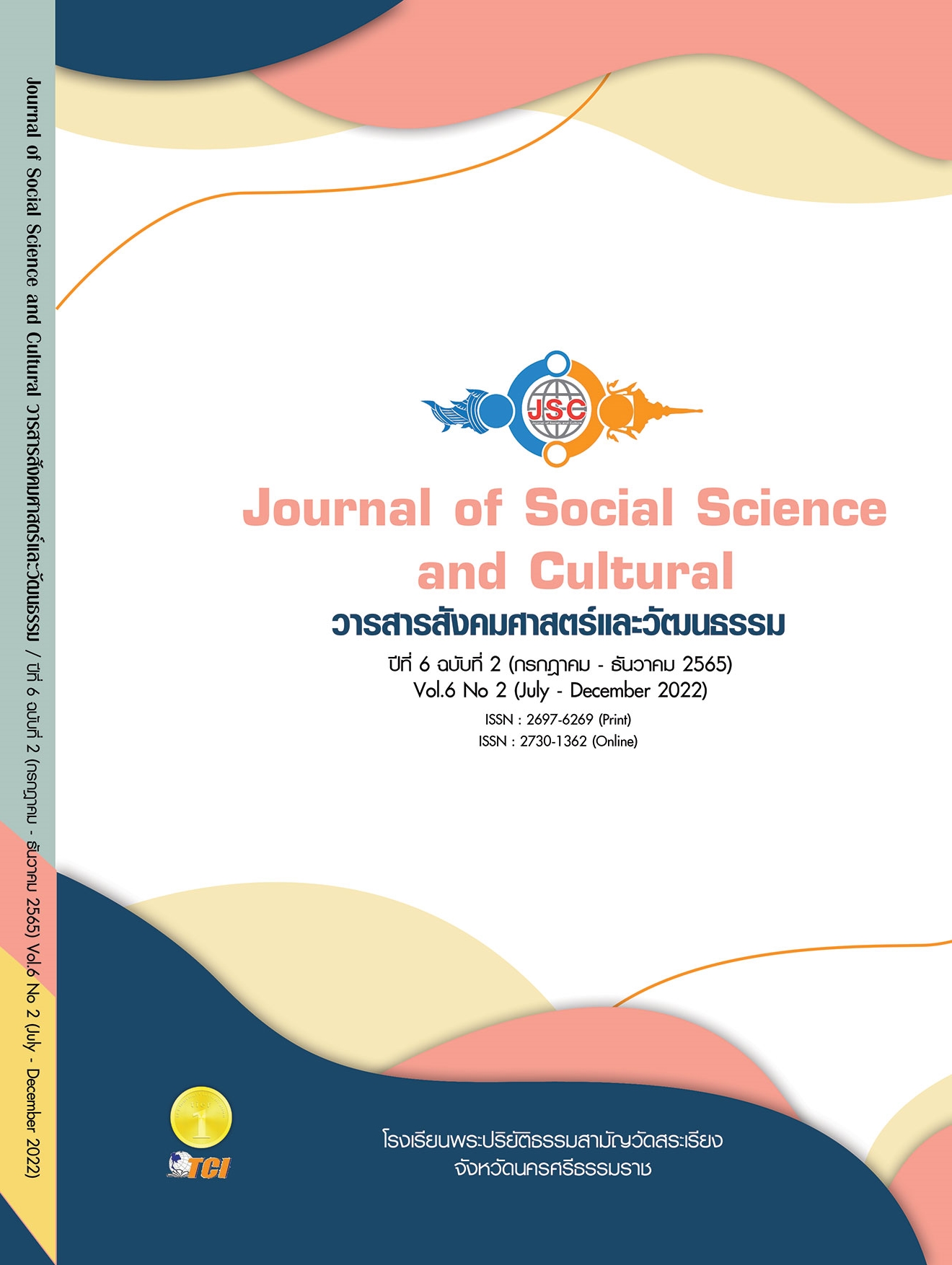GUIDELINES FOR ARTS EDUCATION TO PROMOTE CREATIVE ECONOMY
Main Article Content
Abstract
The Objectives of this research article were to 1) study the importance of conservation. Continuing and managing education in arts and culture 2) Study the integration of art education management cooperation with arts and culture networks, and 3) Propose an art education management approach that promotes the creative economy. It is qualitative research. Collecting field data from administrators and faculty involved in the management of fine arts education. By selecting a specific sample group in accordance with the research objectives, 20 people summarized the preliminary information from the document, analyzed, synthesized and interpreted to create a preliminary conclusion by the researcher. Organized a group discussion meeting of 12 experts to certify the results and provide additional suggestions. The results of the research were as follows: 1) Management of art education Still unable to achieve business results must receive budget support from the government sector and focus on conservation missions 2) Cooperation in management There is a coordination of human capital networks. Social capital and cultural capital with professional dance organizations and groups Music and visual arts to support education management to meet the needs of learners up to the high vocational level and 3) Art management approaches to promote the creative economy is a balanced integration between professional promotion Building academic knowledge and applying wisdom to add value to cultural products. The findings of this research are that the Triple A Methods (Artist career - Academic - Add value) is an approach to promote the creative economy, consisting of education management to create a career to develop academic progress and increase quality value and value for cultural products.
Article Details
References
กระทรวงวัฒนธรรม. (2559). ร่างกรอบทิศทางยุทธศาสตร์ 20 ปี ด้านวัฒนธรรมตามกรอบทิศทางยุทธศาสตร์ชาติ ระยะ 20 ปี. เรียกใช้เมื่อ 5 ตุลาคม 2564 จาก https://www.m-culture.go.th/th/ewt_dl_link.php?nid=7162
กระทรวงศึกษาธิการ. (2561). สรุปประเด็นสำคัญยุทธศาสตร์ชาติ. เรียกใช้เมื่อ 14 มีนาคม 2565 จาก https://www.moe.go.th/moe/th/news/detail.php?NewsID= 53165&Key=news_act
ชาย โพธิสิตา. (2559). ศาสตร์และศิลป์แห่งการวิจัยเชิงคุณภาพ. กรุงเทพมหานคร: อมรินทร์พริ้นติ้ง.
ชินวัตร เชื้อสระคู. (2561). การบริหารเชิงกลยุทธ์: ความท้าทายและข้อเสนอแนะในการจัดการทรัพยากรมนุษย์องค์กรภาครัฐ. วารสารการเมืองการปกครอง, 9(2), 200-215.
ทรูปลูกปัญญา. (2559). คำพ่อสอน -ว่าด้วยเรื่องความสำคัญของการศึกษา ด้านศิลปวัฒนธรรม. เรียกใช้เมื่อ 13 กันยายน 2565 จาก https://www. trueplookpanya.com/knowledge/content/55033/-cul-201611-theme
ธาดา ราชกิจ. (2563). การศึกษา (Education) สำคัญอย่างไรกับการพัฒนาทรัพยากรมนุษย์. เรียกใช้เมื่อ 1 กันยายน 2565 จาก https://th.hrnote.asia/orgdevelopment /190625-education-for-hrd
ประเวศ วะสี. (2554). มองมุมใหม่ จัดการใหม่ ในระบบสุขภาพชุมชน. เอกสารประกอบการประชุมมหกรรมสุขภาพชุมชน ครั้งที่ 2 จากความรู้สู่ระบบจัดการใหม่ จินตนาการเป็นจริงไม่รู้จบ “New Management New Possibility”. กรุงเทพมหานคร: สหมิตรพริ้นติ้งแอนด์พับลิสชิ่ง.
ประกาศเรื่อง ยุทธศาสตร์ชาติ พ.ศ. 2561-2580. (2561). ราชกิจจานุเบกษา เล่ม 135 ตอนที่ 82 ก หน้า 1 13 ตุลาคม 2561.
ผู้ทรงคุณวุฒิ ท่านที่ 1. (2 สิงหาคม 2565). แนวทางจัดการศึกษาเพื่อส่งเสริมเศรษฐกิจเชิงสร้างสรรค์. (ทวีวัฒน์ จิตติเวทย์กุล, ผู้สัมภาษณ์)
ผู้ทรงคุณวุฒิ ท่านที่ 2. (2 สิงหาคม 2565). แนวทางจัดการศึกษาเพื่อส่งเสริมเศรษฐกิจเชิงสร้างสรรค์. (ทวีวัฒน์ จิตติเวทย์กุล, ผู้สัมภาษณ์)
ผู้ทรงคุณวุฒิ ท่านที่ 3. (2 สิงหาคม 2565). แนวทางจัดการศึกษาเพื่อส่งเสริมเศรษฐกิจเชิงสร้างสรรค์. (ทวีวัฒน์ จิตติเวทย์กุล, ผู้สัมภาษณ์)
ผู้ทรงคุณวุฒิ ท่านที่ 4. (2 สิงหาคม 2565). แนวทางจัดการศึกษาเพื่อส่งเสริมเศรษฐกิจเชิงสร้างสรรค์. (ทวีวัฒน์ จิตติเวทย์กุล, ผู้สัมภาษณ์)
ผู้บริหารและคณาจารย์ในหน่วยจัดการศึกษาด้านศิลปกรรม ท่านที่ 1. (20 พฤษภาคม 2565). แนวทางจัดการศึกษาเพื่อส่งเสริมเศรษฐกิจเชิงสร้างสรรค์. (ทวีวัฒน์ จิตติเวทย์กุล, ผู้สัมภาษณ์)
ผู้บริหารและคณาจารย์ในหน่วยจัดการศึกษาด้านศิลปกรรม ท่านที่ 2. (23 พฤษภาคม 2565). แนวทางจัดการศึกษาเพื่อส่งเสริมเศรษฐกิจเชิงสร้างสรรค์. (ทวีวัฒน์ จิตติเวทย์กุล, ผู้สัมภาษณ์)
ผู้บริหารและคณาจารย์ในหน่วยจัดการศึกษาด้านศิลปกรรม ท่านที่ 3. (27 พฤษภาคม 2565). แนวทางจัดการศึกษาเพื่อส่งเสริมเศรษฐกิจเชิงสร้างสรรค์. (ทวีวัฒน์ จิตติเวทย์กุล, ผู้สัมภาษณ์)
ผู้บริหารและคณาจารย์ในหน่วยจัดการศึกษาด้านศิลปกรรม ท่านที่ 4. (5 กรกฎาคม 2565). แนวทางจัดการศึกษาเพื่อส่งเสริมเศรษฐกิจเชิงสร้างสรรค์. (ทวีวัฒน์ จิตติเวทย์กุล, ผู้สัมภาษณ์)
พระครูสังฆรักษ์ศุภณัฐ ภูริวฑฺฒโน และพระพิษณุพล รูปทอง. (2560). การศึกษาคุณค่าของศิลปะปูนปั้นภายในวัดตามการรับรู้ของคนในจังหวัดลำปาง. วารสารวิทยาลัยสงฆ์นครลำปาง, 6(1), 8-16.
พิศิษฐ ตัณฑวณิช และพนา จินดาศรี. (2561). ความหมายที่แท้จริงของค่า IOC. วารสารการวัดผลการศึกษามหาวิทยาลัยมหาสารคาม, 24(2), 3-12.
มณีวรรณ ฉัตรอุทัยและคณะ. (2561). ทุนมนุษย์: ขุมพลังและศักยภาพการแข่งขันของประเทศไทย. วารสารบริหารธุรกิจ นิด้า, 22(พ.ค. 2561), 5-22.
วิรุณ ตั้งเจริญ. (2555). ศิลปกรรมร่วมสมัย: การเรียนรู้และสร้างสรรค์. วารสารสถาบันวัฒนธรรมและศิลปะ, 14(1), 14-20.
สถาบันบัณฑิตพัฒนศิลป์. (2564). ผนพัฒนาสถาบันบัณฑิตพัฒนศิลป์ พ.ศ. 2565–2569. เรียกใช้เมื่อ 3 พฤศจิกายน 2564 จาก http://bpi.ac.th/index.php/en/about-us/management/management5
สุภางค์ จันทวานิช. (2559). วิธีการวิจัยเชิงคุณภาพ. กรุงเทพมหานคร: จุฬาลงกรณ์มหาวิทยาลัย.
อณิษฐา หาญภักดีนิยม และจิตสุภา แกมทับทิม. (2561). “วัฒนธรรมองค์กรของระบบราชการไทย”. วารสารวิทยาลัยสงฆ์นครลำปาง, 7(1), 343-351.


